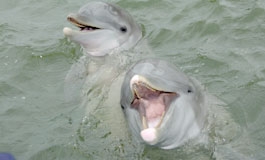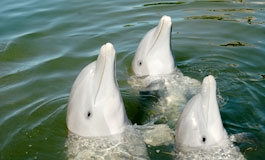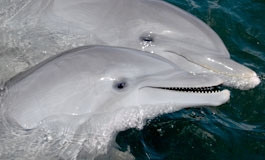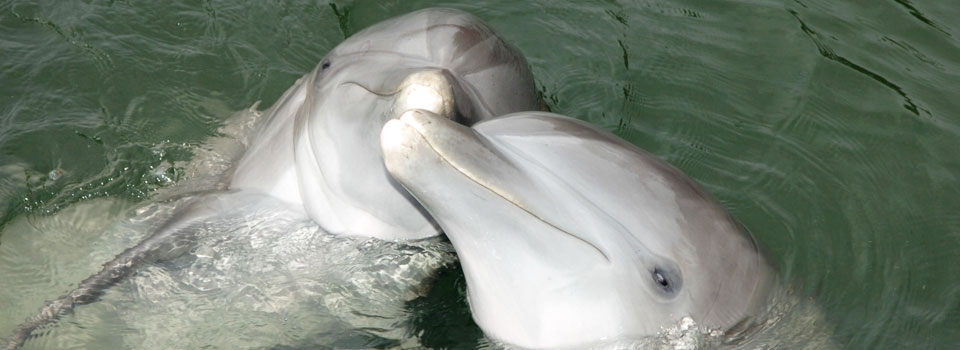- RESEARCH
- LEARN
- Child Education »
- Teen Education »
- Adult Education »
- Resources »
- Kids Zone »
- SHOP

- Providing Sanctuary and a Forever Home since 1984.
- A not-for-profit 501(c)3 marine mammal education and research facility for more than 35 years.
- Providing Sanctuary and a Forever Home since 1984.
A not-for-profit 501(c)3 marine mammal education and research facility for more than 35 years.
Defining Culture
Defining Culture
Do dolphins and whales have culture as we know it? Discover ideas which may point to culture in these animals and the hurdles that scientists contend with when trying to prove that they possess culture.
In order for a species to possess culture, a few basic requirements must be met. One of those requirements is that a species engages in shared behaviors which vary between populations and are perpetuated across generations. Additionally, these behaviors must be acquired through social learning and be independent of genetic factors in order to be considered culturally transmitted.
Bottlenose dolphins show the strongest evidence of possessing culture within the infraorder Cetacea. It is a gregarious species, displaying distinct shared behaviors among different groups, which appear to be passed on from mother to calf or between associated individuals. Bottlenose dolphins are also well known for their strong capacity to observe and imitate both vocalizations and motor skills. This strongly suggests that many behaviors are acquired though social learning. Social learning is the most likely explanation for shared behavior in most cases, but lack of proof keeps this a speculation. Further research is necessary to provide concrete evidence that these behaviors are truly passed on via social learning before science, as a whole, may accept culture in the bottlenose dolphin under the current definition.
Bottlenose dolphins have been extensively studied in both human care and in the wild. They are long-lived animals that can sometimes exceed 30-50 years of age. They are social animals that live in complex, ever changing communities, where individuals have long term associations with other individuals that are repeated but not necessarily constant. Bottlenose dolphin societies are comprised of a large number of individuals with distinct subgroups. These subgroups include:
- maternity bands, made up of females and their calves or females of the same age and state of reproduction
- juvenile groups, consisting of youngsters that have become independent from their mothers
- bachelor groups, alliances of 2-3 adult males which have the most stable bonds in bottlenose dolphin society outside the mother and calf bond (Reynolds, et al., 2000).
Bottlenose dolphins (Tursiops truncatus) are well known for the “plasticity” in their behavior and apparent cognitive ability (Reynolds, et al., 2000). The discovery of these traits, coupled with the social nature of these animals, has led scientists to speculate whether or not bottlenose dolphins and other cetaceans have culture. Seemingly, the most difficult aspect of determining whether a species has culture is the definition of culture itself. Ethologists, biologists, anthropologists and psychologists all have varying views on how to define culture. Some authors define culture in a very broad sense, while others restrict it to certain properties that are often unable to be determined in species outside of humans.
Definitions of Culture:
- “The totality of socially transmitted behavior patterns that characterize the functioning of a group or organization through training or education; enlightenment resulting from such training or education” (American Heritage Dictionary).
- “The integrated pattern of human behavior that includes thought, speech, action, and artifacts and depends upon the human capacity for learning and transmitting knowledge to succeeding generations” (Merriam-Webster).
- “Information or behavior, shared by a population or subpopulation, which is acquired from conspecifics through some form of social learning” (Rendell & Whitehead, 2001).
It is maintained yet by others that the most accepted definition of culture additionally includes imitation and active teaching to achieve true social learning (Deputte, 2001), and that culture is “variation acquired and maintained by social learning which requires the capacity for observational learning” (Boyd, et al., 1995).

Proving Culture in Whales and Dolphins
Proving Culture in Whales and Dolphins
Commentary on culture in cetaceans surrounds research on various topics, rather than an active focus on culture itself. This means the products of research with other objectives must be pulled together to make a case for culture in these animals. The subject of culture in cetaceans has been untouched by direct research and has been only engaged through discussion. Scientists have tried to build a case for culture in cetaceans by looking at a few traits in one species and piecing them together with other species within the infraorder Cetacea (Rendell & Whitehead, 2001). However, each species may not meet the criteria for possession of culture unless an individual species is documented to meet all facets of the definition. Similarly, unless each family within the infraorder Cetacea meets all defined requirements separately, the infraorder as a whole might not agreeably meet the definition of culture. Unfortunately, the difficulty in studying cetaceans, which are predominantly out of sight, generates information that often leaves pieces missing. (Tyack, 2001; Kuczaj, 2001).
The bottlenose dolphin is the most well studied species within the infraorder Cetacea, due to both extensive long term field research and observations taken in human care. The enormous amount of information accumulated on behavior, life history, biology and cognition, make the bottlenose dolphin the best species, within the Cetacea, to investigate possession of culture.

Shared and Perpetuated Behavior
Shared and Perpetuated Behavior
In order for a species to possess culture, it must exhibit shared behaviors unique to certain populations or subgroups and be perpetuated across generations. These behaviors must be socially, rather than independently, learned via observation, imitation and teaching. Dolphins meet most of these requirements in their foraging techniques, play behavior and vocal communication.
Foraging techniques
Populations of bottlenose dolphins, and the subgroups within them, show striking differences in foraging behavior. Certain behaviors are only found and perpetuated among specific groups. Dolphins in some areas forage collectively using complex strategies. In other areas, animals in a group are more likely to hunt individually, using methods which are unique to their group. The most complex and intriguing strategies incorporate cooperative efforts between both groups of dolphins and humans. Culture, however, cannot be attributed to these behaviors until genetic factors, ecological impacts and independent learning of these foraging tactics are ruled out in each case.
In Shark Bay, Australia several distinct foraging methods are found among separate groups of dolphins which live in the same areas (Connor, 2001). Each animal in this area uses more than one foraging method, but animals employ a particular type during most foraging efforts observed. Preferred foraging methods have been documented as passed on from mother to calf, illustrating perpetuation of behavior across generations. Of the calves observed foraging, 87% exhibited only those strategies used by their mothers (Mann, et al. 2001, a.).
Two examples of individual methods shared by members of a given group highlight group distinctiveness and exemplify vertical transmission of behavior (i.e. perpetuation from mother to offspring). Sponge carrying is probably the most unique method of hunting and has not been observed in any other area but the deep canals of Shark Bay. Animals carry sponges on their rostrums and dive down to the sea floor. It has been hypothesized that the sponges are employed to protect the animals’ rostrums from damage by prey or sea bottom (Smolker, et al., 1997). This behavior is limited to a small number of strictly female dolphins and their calves and occurred in 67-100% of feeding bouts observed for these animals. (Smolker, et al., 1997). Sponge feeding transpired only in deep channels that were used as foraging grounds by other animals, never seen sponge feeding (Mann, et al., 2001, b.). Only calves born to sponge-using mothers were observed to develop this behavior (Mann, et al., 2001, a.).
Hydroplaning
Hydroplaning is another distinct foraging strategy restricted to a separate band of 20 females and their offspring in the Shark Bay area (Berggren, et al., 1995). During hydroplane feeding, dolphins use the shoreline as a barrier, hydroplaning on the surface of the water while herding their prey closer to the shoreline until it has less maneuverability than the dolphin (Berggren, et al., 1995). Both of these unique strategies most certainly indicate transmission of behavior from mother to offspring (Mann, 2001, b.).
Genetics are an unlikely cause of behavioral transmission, as dolphins are known to be polygamous (a female will mate with different males and therefore the offspring will not necessarily have the same father). Males range much farther than females, in most populations of dolphins, and are unlikely to repeatedly mate with the same individual (Reynolds, et al., 2000). A genetic cause would then require the female’s genes to be dominant approximately 90-100% of the time to perpetuate specific behaviors like sponge feeding in offspring. The study of genetics tells us this is unlikely and, therefore, is not the most plausible explanation, though more testing must be done to entirely rule it out. Ecological factors certainly play a part in these behaviors, as in many cases, outside of sponge feeding, group home ranges overlap, but feeding areas do not. However, social learning does not have to be independent of ecological factors and may in fact work in unison (Connor, 2001). Calves spend, on average, 3-6 years with their mothers, during which time they are exposed to maternal foraging techniques. Since calves go on to predominately use a method of foraging used at one time by their mothers and dolphins are well known for their observation and imitative abilities, speculation would make social learning a likely explanation for the transmission of these foraging techniques. Unfortunately, no research, to date, gives absolute evidence of this. Investigation on foraging behavioral development in calves is necessary in order to determine whether social, rather than independent, learning is truly at play.
Dolphins have been found to employ cooperative group efforts when foraging. The most complex group strategy involves the “use” of humans during foraging. This dolphin-human cooperative occurs in Laguna, Brazil and has perpetuated for well over three generations of dolphins (Pryor, 1990). Members of a resident population of dolphins fish jointly with local fisherman on a daily basis. This practice is said to have been in existence since 1847. A group of dolphins will collectively follow a school of fish near the shore, wait while fishermen position themselves, and then chase the fish at the net, stopping with a specific body roll, which informs the fishermen of the right time to cast their net. Both fishermen and dolphins then reap the rewards of the fish corralled between them. Fishermen take what is in their net and the dolphins eat fish outside of the net. The fishermen never feed or touch the dolphins.
If a school is thin, the dolphins will search for another school of fish farther down the beach and wait for the fishermen to get into position before chasing the fish toward the net again. Since scientists were alerted to this behavior, 22 animals, including three generations of female dolphins and their offspring, have been documented to participate. Other animals of the same population, which forage in the same area, do not participate at all, indicating ecological factors are not in play (Pryor, 1990). The complexity of this behavior rules out genetic factors. This unique cooperative foraging method is a group dependent effort and therefore cannot be independently learned. The resulting conclusion is that this behavior must be passed on through social learning via mothers or associated animals.
Play behavior
Rapid transfer of behavior in less than a generation is a good indicator of cultural transmission through social learning, as genetic causes can be excluded. Dolphins in human care are well known to discover new play behaviors, which are quickly perpetuated through the population. Anecdotal observations of bubble play, wearing seaweed, and teetering on tank edges are examples of behaviors that started with one dolphin and quickly became “the fashion” among the population (Pryor, 2001; McCowan, et al., 2000). The rapidity with which play behavior has been observed to spread in human care populations makes genetic factors and independent learning unlikely. These behaviors are most likely imitated among associated animals. These types of “fads” need more study to rule out ecological factors and independent learning in order to be attributed to cultural effects.
Whistle sharing
Male dolphins in alliances in both Australia and Sarasota, Florida, have been found to modify their original signature whistles and converge on a similar whistle type to that of their alliance partner (Smolker, et al., 1999; Watwood, et al., 2004). Restrained adult male animals in the Sarasota study were more likely to have signature whistles that were similar to their partners than to that of other male dolphins (Watwood, et al., 2004). Whistle convergence in both studies was hypothesized as a display of affiliation and the broadcasting of it. Whistle sharing would then identify members of a particular group, separating them from others, a necessity for culture. Whistle sharing between males requires both parties to participate, making social learning the obvious mechanism in action, also a necessity for culture. While this phenomenon appears to fit the definition of culture, it does not show the perpetuation of a specific behavior to future generations. Indeed, part of the mechanism or root cause for convergence may be genetic, though the creation of the new whistle is learned. Whistle convergence among males certainly capitalizes on imitation, a necessary property of social learning, at which dolphins are very adept.

Social Learning
Social Learning
Social learning is necessary toward defining culturally acquired behaviors and is described as the ability to learn new behaviors from others through observation, imitation and teaching.
Imitation
Behaviors described throughout this paper appear to capitalize on observation and imitation. Imitation must be proven in the species in order to speculate that it is being used in the wild. This ability has been well shown in the bottlenose dolphin and lends support toward the speculation of culture in this species. Dolphins have an outstanding capacity for vocal and motor imitation (Herman, 2001). It is, therefore, not surprising to find that they employ this capacity in every day life.
Imitation appears to be extremely important to the social nature of dolphin lifestyles. Dolphins move most often in unison with associated animals in their groups. This synchrony may be the very foundation of imitation development. It provides visual cues that transmit information rapidly without the need for sound, which can alert potential prey or predators to a dolphin’s presence. Mothers and calves travel in synchrony, which may help in calf development of swimming and social skills necessary later in life (Fellner, et al., 2001).
Imitation contributes further to a dolphin’s social needs. Dolphins have been documented to have individually specific whistles within their vocal repertoires that remain generally stable over their life times (Caldwell, 1965; Sayigh, et al., 1990). During a study using a device called a vocal light, Peter Tyack found that dolphins imitate signature whistles of other animals. These lights were worn by animals in human care and would light up when the individual wearing it vocalized, making it easy to identify the whistler. In this manner the dolphins were discovered to mimic each other’s whistles (Tyack, 1991).
Tyack went on to document another case of imitation during the temporary restraint of a wild dolphin from the Sarasota population. While restrained on a raft, a female named Nicklo began imitating the known signature whistle of another individual in the net corral named Granny. Granny responded and they both exchanged repetitions of Granny’s whistles. None of the other four animals responded to Nicklo’s whistles, including Nicklo’s own calf (Tyack, 1999). Both events were hypothesized to illustrate that dolphins may use signature whistle imitation to address other specific individuals. Vincent Janik conducted a study on undisturbed wild dolphins using an array of hydrophones that were placed in advance. He found that the animals recorded also engaged in whistle matching and at distances of 179-579 meters from each other, lending support to the hypothesis that dolphins may use whistle imitation to address particular individuals (Janik, 2000). While genetics can be ruled out in the first two studies, as all animals were unrelated, these three studies cannot rule out the possibility the animals did not have these whistles already in their repertoire since birth. However, evidence from studies on signature whistle development make this highly unlikely (Sayigh, et al., 1990).
The bottlenose dolphin is not restricted to vocal imitation. Their ability to observe and imitate is more complex and includes copying motor skills of other associates and other species such as sea lions, turtles and humans (Bauer, et al., 2001, Herman, 2001).
Teaching
Teaching is the aspect of social learning for which there is no hard evidence to illustrate that it exists in the bottlenose dolphin. Teaching implies the intention to pass information or skills to a student, an understanding that the student lacks knowledge in those areas being taught, and that the teacher generally does so without benefit to themselves (Herman, 2001). Calves follow their mothers and certainly learn by observation and imitation, but nothing yet observed demonstrates active teaching on the part of the mother. Such is the case with play behaviors as well. Anecdotal evidence, from observations and video, shows hydroplane-foraging mothers escorting calves on hydroplane runs down the beach, which do not involve chasing fish. It is possible that this may be teaching, but could also be a form of play. Neither can be known for sure. If teaching is a necessary component of the definition of culture, bottlenose dolphins currently do not meet it until evidence of this aspect is found. Research is needed to determine how bottlenose dolphins learn group specific behaviors and if teaching is truly involved.
"Learning would be exceedingly laborious, not to mention hazardous, if people had to rely solely on the effects of their own actions to inform them what to do” (Bandura, 1977). This quote holds true for the complexity of dolphin behaviors. Social learning allows dolphins to quickly develop skills necessary for survival. The less time spent in developing behaviors, the more time animals can focus on employing them to retain fitness and reproduce.

Do Bottlenose Dolphins Have Culture?
Do Bottlenose Dolphins Have Culture?
The question of whether or not bottlenose dolphins have culture will have to remain open until further study provides more evidence. These animals are the most likely candidates among the infraorder Cetacea, based on current knowledge available. However, gaps in that knowledge prevent bottlenose dolphins from meeting the generally accepted, full criteria for the possession of culture.
The complexity and diverse nature of foraging strategies between different groups of dolphins makes a strong case for culture, as these behaviors appear to be socially learned and are perpetuated across generations. Individual foraging tactics have been shown to pass from mother to calf. Group foraging, as in the case of the Laguna dolphins, is multi-generational and is also a group dependent effort showing social learning. Teaching, as a component of the definition of culture, has yet to be demonstrated, though dolphins certainly fulfill other aspects of the social learning criterion via observation and imitation. The rapidity with which play behavior has been observed to spread in human care populations makes imitation of other animals the most likely tool of transmission rather than genetic factors or independent learning. The same holds true for whistle convergence and whistle matching. Whistle matching and convergence can provide evidence of social learning, but do not provide evidence of culture as they are not behaviors, which are passed on through generations and are a function between only two to three animals. Research, specifically on the development of foraging and play behaviors, is necessary to provide concrete evidence of what types of social learning are involved. Further evidence that genetic and ecological factors are not at play will also create stronger backing for the likelihood of social learning. Teaching is the most questionable factor remaining in the fulfillment of the definition of culture and has yet to be demonstrated. Scientists may need to investigate and define “levels” of culture, as suggested by Dunbar (2001), illustrating varying degrees that certainly must have led to the development of culture in humans.
Until further research is done to resolve questions surrounding behavioral development and mechanisms of transmission, the existence of culture in the bottlenose dolphin cannot yet be determined for certain. Cetaceans may remain subject to what Karen Pryor calls the “Galileo syndrome” (Pryor, 2001), truly having culture but subject to the delayed progression of thought in the whole of humanity.

References
References
The American Heritage® Dictionary of the English Language, Fourth Edition
(2000) Houghton Mifflin Company. Bandura, A. (1977). Social Learning Theory. New York: General Learning Press.
Bauer G.B., Harley H.E. (2001) The mimetic dolphin. Behavioural and Brain Sciences. 24: 326-327. Berggren P., Skelton J. (1995) Beaching foraging strategy of bottlenose dolphins (Tursiops sp.) in Shark Bay, Western Australia. Eleventh Biennial Conference on Marine Mammals, Orlando, FL.
Boyd R., Richerson P.J. (1995) Why Culture is Common but Cultural Evolution is Rare. Royal Society Symposium/British Academy Symposium on Evolution of Social Behaviour Patterns in Primates and Man.
Byrne R.W., Russon A.E. (1998) Learning by imitation: A hierarchical approach. Behavioural and Brain Sciences. 21: 667-721. Caldwell MC, Caldwell DK (1965) Individualized whistle contours in bottlenosed dolphins (Tursiops truncatus). Nature 207:434–435 Connor R.C. (2001) Individual foraging specializations in marine mammals: Culture and ecology. Behavioural and Brain Sciences. 24: 327-330. Chilvers L., Corkeron P. (2001) Trawling and bottlenose dolphins’ social structure. Proceedings of the Royal Society of London. 268: 1901-1905. Deputte B.L. (2001) Culture in cetaceans: Why put the cart before the horse?. Behavioural and Brain Sciences. 24: 330-331. Dictionary. com, Merriam-Webster Dictionary, 2002 Merriam-Webster, Inc. Ding, Wang; Wuersig, B; Evans, WE (1995) Whistles of bottlenose dolphins: Comparisons among populations. Aquatic Mammals. 21: 65-77 Dunbar R.I.M. (2001) So how do they do it? Behavioural and Brain Sciences. 24: 332-333. Fellner W., Bauer G.B. (2001) Synchronous Movement as a Potential Medium For Cultural Transmission. Culture Workshop at the 14th Biennial Conference on the Biology of Marine Mammals.
Freeberg T.M. (2001) Communicative cultures in cetaceans: Big questions are unanswered, functional analyses are needed. Behavioural and Brain Sciences. 24: 334.
Herman L.M., Pack A. A. (2001) Laboratory evidence for cultural transmission mechanisms. Behavioural and Brain Sciences. 24: 335-336.
Janik V.M. (2001) Is cetacean social learning unique? Behavioural and Brain Sciences. 24: 337-338.
Janik VM (2000) Whistle matching in wild bottlenose dolphins (Tursiops truncatus). Science 289:1355–1357
Krutzen M., Sherwin W.B. (2001) MtDNA Analysis Suggests that Sponge Carrying by Bottlenose Dolphins in Shark Bay, Australia is a Pattern of Vertical Mother-Offspring Cultural Transmission. Culture Workshop at the 14th Biennial Conference on the Biology of Marine Mammals.
Kuczaj S. (2001) Cetacean culture: Slippery when wet. Behavioural and Brain Sciences. 24: 340-341.
Mann J. (2001, a.) Cetacean culture: Definitions and evidence. Behavioural and Brain Sciences. 24: 343.
Mann J., Sargeant, B. (2001, b.) Like Mother, like Calf: The Ontogeny of Foraging Specializations in Shark Bay, Western Australia. 14th Biennial Conference of Marine Mammals, Society of Marine Mammalogy. Vancouver, B.C.
McCowan B., Marino L., Reiss D., Vance E., Walke L. (2000) Bubble Ring Play of Bottlenose Dolphins (Tursiops truncatus): Implications for Cognition. Journal of Comparative Psychology. 114: 1: 98-106.
Miksis JL, Tyack PL, Buck JR (2002) Captive dolphins, Tursiops truncatus, develop signature whistles that match acoustic features of human-made model sounds. J Acoust Soc Am 112:728–739
Pryor K.W. (1990) A Dolphin-Human Fishing Cooperative in Brazil. Marine Mammal Science, 6(1): 77-82.
Pryor K.W. (2001) Cultural transmission of behaviour in animals: How a modern training technology uses spontaneous social imitation in cetaceans and facilitates social imitation in horses and dogs. Behavioural and Brain Sciences. 24: 352.
Rendell L., Whitehead H. (2001) Culture in whales and dolphins. Behavioural and Brain Sciences. 24: 309-324.
Rendell L., Whitehead H. (2001) Cetacean culture: Still afloat after the first naval engagement of the culture wars. Behavioural and Brain Sciences. 24: 360-364.
Rogers A. (1988) Does Biology Constrain Culture? American Anthropologist, 90(4): 819-831.
Sayigh LS, Tyack PL, Wells RS, Scott MD (1990) Signature whistles of free-ranging bottlenose dolphins Tursiops truncatus: stability and mother–offspring comparisons. Behav Ecol Sociobiol 26: 247–260
Sayigh LS, Tyack PL, Wells RS, Solows AR, Scott MD, Irvine AB (1998) Individual recognition in wild bottlenose dolphins: a field test using playback experiments. Animal Behaviour 57: 41-50
Slater P.J.B. (2001) There’s CULTURE and “Culture”. Behavioural and Brain Sciences. 24: 356-357.
Smolker R., Richards A., Connor R., Mann J., Berggren P. (1997) Sponge carrying by dolphins (Delphinidae, Tursiops sp.): A foraging specialization involving tool use? Ethology. 103(6),: 454-465.
Smolker RA, Pepper JW (1999) Whistle convergence among allied male bottlenose dolphins (Delphinidae, Tursiops sp). Ethology 105: 595–617
Thomas R. (2001) Marine versus terrestrial variability in relation to social learning. Behavioural and Brain Sciences. 24: 357.
Tschudin A. (2001) Getting at animal culture: The interface of experimental and ethnographic evidence in dolphins. Behavioural and Brain Sciences. 24: 357-358.
Tyack P.L. (2001) Cetacean culture: Humans of the sea? Behavioural and Brain Sciences. 24: 358-359.
Tyack PL (1999) Communication and Cognition. Pp 287-323. In: Reynolds JE, Rommel SA (1999) Biology of Marine Mammals. Smithsonian Institution Press. Washington
Tyack PL (1991) Use of a Telemetry Device to Identify which Dolphin Produces Sound. Pp. 319-344. In: Pryor K, Norris KS (1991) Dolphin Societies. University of California Press. Berkley, California
Watwood SL, Tyack PL, Wells RS (2004) Whistle sharing in paired male bottlenose dolphins, Tursiops truncatus. Behavioural Ecology and Sociobiology. 55(6): 531-541
Whiten A. (2001) Imitation and cultural transmission in apes and cetaceans. Behavioural and Brain Sciences. 24: 358-359.

Our Mission -
Through education, research and rescue, Dolphin Research Center promotes peaceful coexistence,
cooperation and communication between marine mammals, humans and the environment we share with
the well being of DRC's animals taking precedence.













